新职业英语视听说教程(上册)教案
- 格式:doc
- 大小:247.50 KB
- 文档页数:98
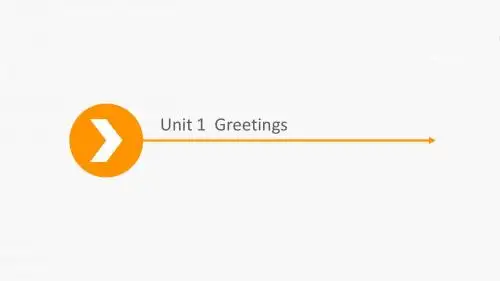
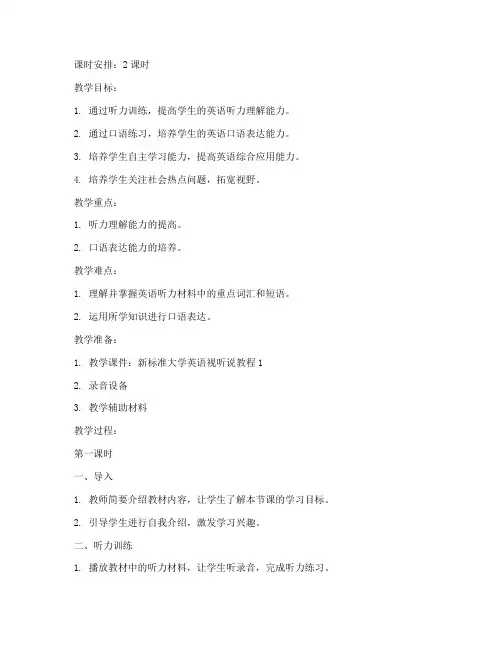
课时安排:2课时教学目标:1. 通过听力训练,提高学生的英语听力理解能力。
2. 通过口语练习,培养学生的英语口语表达能力。
3. 培养学生自主学习能力,提高英语综合应用能力。
4. 培养学生关注社会热点问题,拓宽视野。
教学重点:1. 听力理解能力的提高。
2. 口语表达能力的培养。
教学难点:1. 理解并掌握英语听力材料中的重点词汇和短语。
2. 运用所学知识进行口语表达。
教学准备:1. 教学课件:新标准大学英语视听说教程12. 录音设备3. 教学辅助材料教学过程:第一课时一、导入1. 教师简要介绍教材内容,让学生了解本节课的学习目标。
2. 引导学生进行自我介绍,激发学习兴趣。
二、听力训练1. 播放教材中的听力材料,让学生听录音,完成听力练习。
2. 教师针对听力材料中的重点词汇和短语进行讲解,帮助学生理解。
3. 学生分组讨论,分享听力感受,互相纠正发音。
三、口语练习1. 教师根据教材内容,设计相关话题,引导学生进行口语练习。
2. 学生分组进行角色扮演,模拟实际场景,提高口语表达能力。
3. 教师对学生的口语表达进行点评,指出不足,提出改进建议。
四、总结1. 教师对本节课的学习内容进行总结,强调重点和难点。
2. 学生分享学习心得,提出疑问。
第二课时一、复习导入1. 复习上一节课的学习内容,巩固所学知识。
2. 学生分享口语练习心得,互相借鉴。
二、听力训练1. 播放教材中的听力材料,让学生听录音,完成听力练习。
2. 教师针对听力材料中的重点词汇和短语进行讲解,帮助学生理解。
3. 学生分组讨论,分享听力感受,互相纠正发音。
三、口语练习1. 教师根据教材内容,设计相关话题,引导学生进行口语练习。
2. 学生分组进行角色扮演,模拟实际场景,提高口语表达能力。
3. 教师对学生的口语表达进行点评,指出不足,提出改进建议。
四、总结1. 教师对本节课的学习内容进行总结,强调重点和难点。
2. 学生分享学习心得,提出疑问。
教学评价:1. 课后,教师检查学生的听力练习和口语练习完成情况。
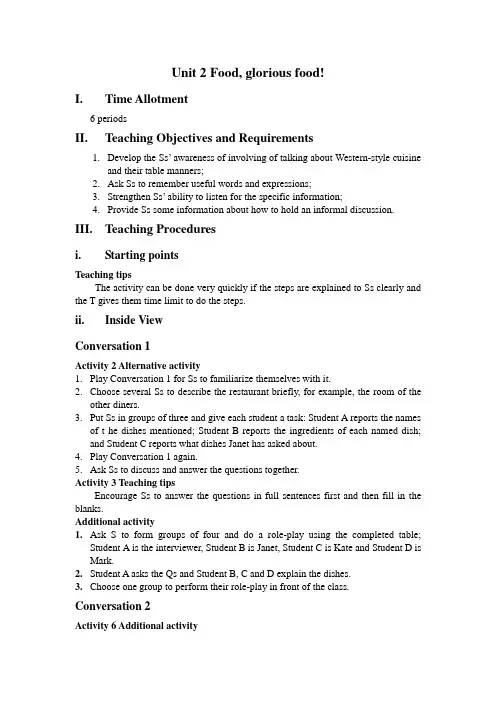
Unit 2 Food, glorious food!I.Time Allotment6 periodsII.Teaching Objectives and Requirements1.Develop the Ss’ awareness of involving of talking about Western-style cuisineand their table manners;2.Ask Ss to remember useful words and expressions;3.Strengthen Ss’ ability to listen for the specific information;4.Provide Ss some information about how to hold an informal discussion. III.Teaching Proceduresi.Starting pointsTeaching tipsThe activity can be done very quickly if the steps are explained to Ss clearly and the T gives them time limit to do the steps.ii.Inside ViewConversation 1Activity 2 Alternative activity1.Play Conversation 1 for Ss to familiarize themselves with it.2.Choose several Ss to describe the restaurant briefly, for example, the room of theother diners.3.Put Ss in groups of three and give each student a task: Student A reports the namesof t he dishes mentioned; Student B reports the ingredients of each named dish;and Student C reports what dishes Janet has asked about.4.Play Conversation 1 again.5.Ask Ss to discuss and answer the questions together.Activity 3 Teaching tipsEncourage Ss to answer the questions in full sentences first and then fill in the blanks.Additional activity1.Ask S to form groups of four and do a role-play using the completed table;Student A is the interviewer, Student B is Janet, Student C is Kate and Student D is Mark.2.Student A asks the Qs and Student B, C and D explain the dishes.3.Choose one group to perform their role-play in front of the class. Conversation 2Activity 6 Additional activity1.Put Ss back in to their groups of four.2.Ask Ss to read through the conversation, aiming for greater fluency.3.Student A is Janet, Student B is Mark, Student C is Kate and Student D is thewaitress.Talking pointsAdditional activityChallenge Ss to summarize the contrasts between Britain and China without looking at their notes.iii.Outside viewLanguage and cultureA Creole is someone with European and African ancestors who live in the West Indies. The term also refers to someone with Spanish ancestors who live in the Caribbean, Central America or South America.Creole is also the name of a language that is mixture of a European language and one or more other languages. It is spoken as the first language of a people.The specific example in the video is the French Creole people of Louisiana who are generally descended from three heritages: early French settlers, African Americans and Native Americans. Many Creoles speak a variety of French, besides English. iv.Listening inPassage 1Activity 3 Teaching tipsAsk Ss to check their answers by reading the complete transcripts to each other. Encourage fluent and meaningful reading.Passage 2Activity 6 Teaching tipsAsk Ss to pay attention to the details while listening. The most important information is spoken with stress..Activity 8 Teaching tipsFor Q1, ask Ss to work in pairs: Student A expresses opinions which agree with the questions, while Student B disagrees. Encourage Ss to use the content of the unit and their own experiences. Ask Ss to switch roles for the question.v.Presentation skillsLanguage supportSome basic English terms for some Chinese dishes which would be known by westerners:Chinese fried rice (炒饭);stir-fried vegetables(炒青菜); fried noodles (炒面); hand-pulled / hand-stretched noodles(拉面); vermicelli(粉丝); dim sum(点心); spring rolls (春卷); steamed meat / vegetable buns (肉、菜包); fried / steameddumplings (煎饺、蒸饺); spare ribs(排骨); bean curd (toufu)(豆腐); hotpot (火锅); Peking duck(北京烤鸭); won ton soup(馄饨); hot and sour soup(酸辣汤); soup noodles(汤面); beef / fish balls(牛肉丸、鱼丸).Ways of cooking in Chinese cuisine: food can be steamed, stir-fried(炒), deep-fried(炸), shallow-fried(煎), braised(炖),roasted(烤), pan-grilled(平底锅煎烤), boiled(煮), baked(烘烤), stewed(炖烧), sautéed (爆炒), and barbecued(烧烤).Meat and vegetables can be cut into cubes(方块,丁), small pieces(小片), strips(丝、条), and segments(片、节). They can be sliced(切片), diced(切块), shredded(刨丝), and minced(绞碎).You can add seasoning(调味料), herbs(香草料), onion(洋葱), spring onions (小葱), garlic(蒜头), ginger(姜), black pepper(黑胡椒), salt, red / green pepper, chili, paprika(辣椒粉), oyster sauce(耗油), soy sauce(酱油), sweet and sour sauce (甜酸酱、糖醋酱), and barbecue sauce(烧烤酱).vi.PronunciationTeaching tips1.Choose a sentence or two to read aloud by using a wrong stress pattern and ask Ssto interpret meanings from the wrong stress pattern.2.Read aloud with a correct stress pattern and explain how meanings are expressedwith correct stress pattern.vii.Unit tasks。
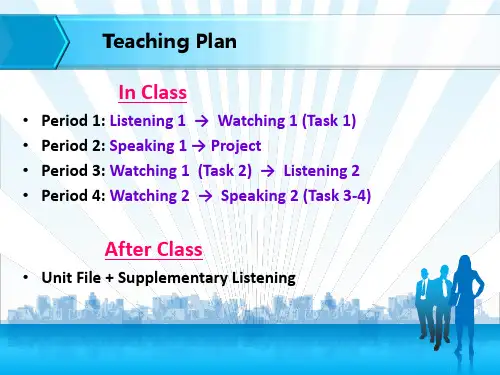
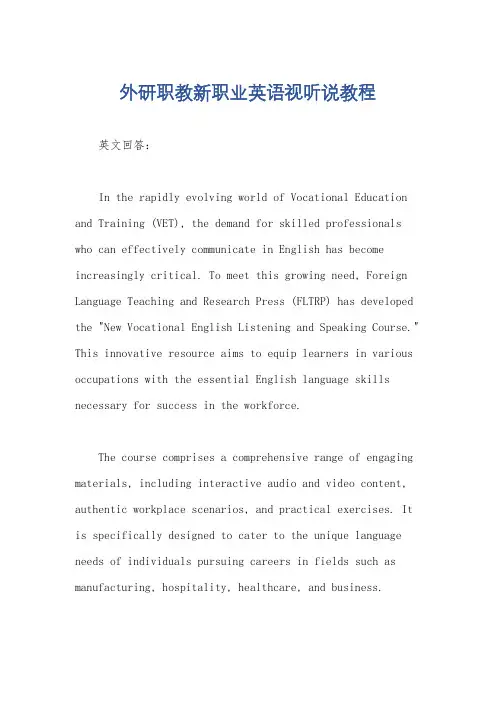
外研职教新职业英语视听说教程英文回答:In the rapidly evolving world of Vocational Education and Training (VET), the demand for skilled professionals who can effectively communicate in English has become increasingly critical. To meet this growing need, Foreign Language Teaching and Research Press (FLTRP) has developed the "New Vocational English Listening and Speaking Course." This innovative resource aims to equip learners in various occupations with the essential English language skills necessary for success in the workforce.The course comprises a comprehensive range of engaging materials, including interactive audio and video content, authentic workplace scenarios, and practical exercises. It is specifically designed to cater to the unique language needs of individuals pursuing careers in fields such as manufacturing, hospitality, healthcare, and business.The course structure follows a modular approach, with each unit focusing on a particular workplace context. This immersive approach allows learners to develop their communication skills in realistic and relevant situations. The lessons are designed to enhance speaking fluency, improve listening comprehension, expand vocabulary, and foster cultural awareness.One of the key features of the course is its focus on developing functional language skills. Learners are guided to acquire the essential vocabulary and phrases necessary for effective communication in their specific occupational area. They will also learn how to express opinions, ask for clarification, handle complaints, and engage in workplace discussions.Another important aspect of the course is the incorporation of authentic materials. This includes real-life interviews with industry professionals, workplace videos, and news reports. This exposure to authentic language allows learners to develop a deeper understanding of the language used in their chosen field.The course is delivered through an interactive online learning platform, which offers flexible and convenient access to the materials. Learners can engage with the lessons at their own pace, participate in group discussions, and interact with instructors and peers.To cater to the diverse learning needs of individuals, the course is available in both online and offline formats. The online platform provides a collaborative and engaging learning environment, while the offline materials offer flexibility for learners who prefer self-study.The "New Vocational English Listening and Speaking Course" is an invaluable resource for individuals seekingto enhance their English language skills for success intheir chosen career. It provides a structured and practical approach to developing the communication abilitiesessential for effective participation in the global workforce.中文回答:外研职教新职业英语视听说教程是外语教学与研究出版社针对职业教育与培训领域日益增长的英语沟通需求而开发的一套创新性资源。
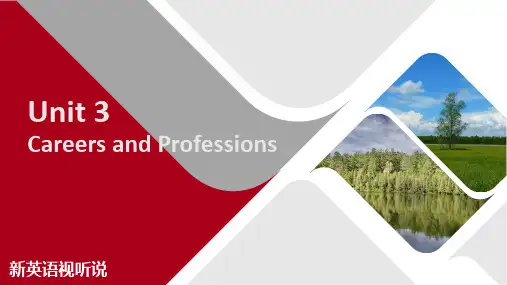
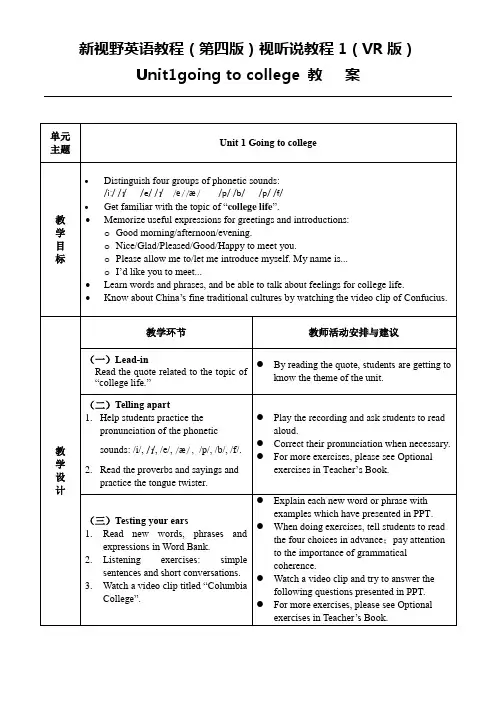
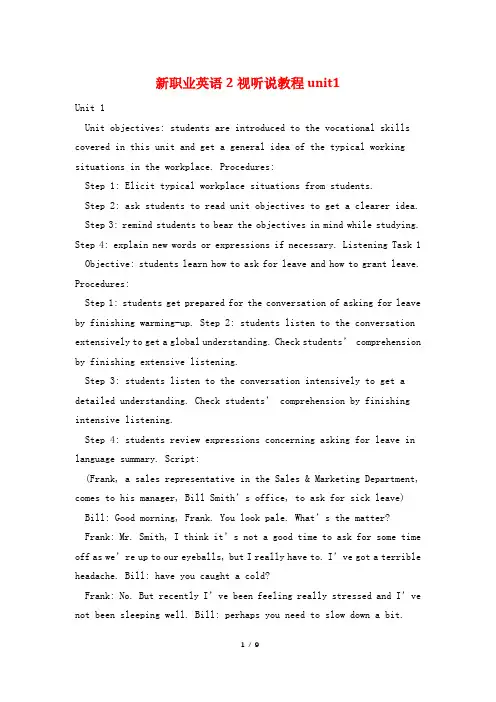
新职业英语2视听说教程unit1Unit 1Unit objectives: students are introduced to the vocational skills covered in this unit and get a general idea of the typical working situations in the workplace. Procedures:Step 1: Elicit typical workplace situations from students.Step 2: ask students to read unit objectives to get a clearer idea. Step 3: remind students to bear the objectives in mind while studying. Step 4: explain new words or expressions if necessary. Listening Task 1 Objective: students learn how to ask for leave and how to grant leave. Procedures:Step 1: students get prepared for the conversation of asking for leave by finishing warming-up. Step 2: students listen to the conversation extensively to get a global understanding. Check students’ comprehension by finishing extensive listening.Step 3: students listen to the conversation intensively to get a detailed understanding. Check students’ comprehension by finishing intensive listening.Step 4: students review expressions concerning asking for leave in language summary. Script:(Frank, a sales representative in the Sales & Marketing Department, comes to his manager, Bill Smith’s office, to ask for sick leave)Bill: Good morning, Frank. You look pale. What’s the matter?Frank: Mr. Smith, I think it’s not a good time to ask for some time off as we’re up to our eyeballs, but I really have to. I’ve got a terrible headache. Bill: have you caught a cold?Frank: No. But recently I’ve been feeling really stressed and I’ve not been sleeping well. Bill: perhaps you need to slow down a bit.Frank: That’s the reason why I’ve come to ask for leave. And on top of it all, my mother had a heart attack yesterday. She’s in hospital. Bill: I’m really sorry to hear that.Frank: I really need some personal time to spend with my mother. Could I have a week off?Bill: That’s going to be difficult as we’re so understaffed at the moment…But Frank, family comes first, so take some time off. All I ask is: could you please submit a detailed progress report before you go? Frank: Yes, of course. I can get that done this afternoon. By this way, Lisa has offered to do some work on my project while I’m away. And I’ll get back as soon as possible.Bill: Good, thanks for that. Give my best wishes to your mother. I hope she gets better soon. Frank: thank you. Key:1. warming upfatigue concentration trouble muscle trouble headaches stomach problems restless sleep2. extensive listening 1. his headache 2. his stress3. his bad sleep4. his heart disease5. his sick mother 3. intensive listening C B B Task 2 Team CooperationObjective: students can talk about team building and cooperation in the workplace. Procedures:Step 1: students get prepared for the conversation of asking for leave by finishing warming-up. Step 2: students listen to the conversation extensively to get a global understanding. Check students’ comprehension by finishing extensive watching.Step 3: students listen to the conversation intensively to get a detailed understanding. Check students’ comprehension by finishing intensive watching. Script:(Bill goes to the project team to encourage them and to see if he can offer some help) Bill: I’ve heard that some team members have been complaining. Jenny: It’s because we’ve been under great pressure recently.John: Our marketing plan was turned down again yesterday. I feel very frustrated. Bill: Well, frustration is not terrible. What’s terrible is to expect failure.John: What makes me despair is that Frank is not here. If he were here, we’d probably have managed to work out effective marketing strategies that would have been accepted.Bill: Well, Lisa can help you. She’s taken over Frank’s work and will work with you on the strategy.Lisa: I will do my best to help. In my opinion, if the work is difficult, it’s better to use all the strengths of the team. We can bring all our abilities and wisdom into full play.John: Yeah, well, that sounds right. Maybe I have to learn to manage myself better. I have to realize the importance of cooperation.Bill: Cooperation is most important for us all. Well, is there anything else I can do for your team, Jenny?Jenny: No. Thanks. We’ll probably encounter some more difficulties, but together we can get through them and achieve our goals.Bill: Wonderful. I’m happy to see that you have self-confidence and the spirit of cooperation. Jenny: Thanks very much. Key:2. extensive watchingJohn has taken Frank’s place to help the team work on the marketing strategies Lisa feels disappointed because of experiencing difficulties in the work again 3. intensive watchinga. False …some team members have been complainingb. True If he were here, we’d probably have managed to work out effectively marketingstrategies…c. False Maybe I have to manage myself better. Task 3 SpeakingObjective: This part aims at guiding students to practice the skills they’ve learned in listening andwatching. Students achieve communication skills in asking for leave, building mutual trust and team cooperation.Procedures:Step 1: explain the task and lead students through the sentence given. Step 2: put students into pairs and ask them to think of as many expressions or sentences aspossible about asking for and granting leave of absence.Step 3: ask students to take turns to read aloud the sentences. Circulate to provide help ifnecessary.Step 4: call on volunteers or selected pairs to make a presentation to the class. Sample:…have a week off work…my father had a stroke due to high blood pressure. …take a half-day off…I need to go for a health checkup. Unit 2Unit objectives: students are introduced to the vocational skills covered in this unit and get ageneral idea of the typical situations encountered when preparing for and having meetings.Procedures:Step 1: elicit typical working situations for preparing for and having meetings from students. Step 2: ask students to read unit objectives to get a clearer idea.Step 3: remind students to bear the objectives in mind while studying. Step 4: explain new words or expressions if necessary. Task 1 Reason for a MeetingObjective: students can give reasons for or against having a meeting. Procedures:Step 1: students get prepared for the conversation concerning reasons for a meeting by finishingwarming up.Step 2: students listen to the conversation extensively to get a global understanding. Checkstudents’ comprehension by finishing extensive listening.Step 3: students listen to the conversation intensively to get a detailed understanding. Checkstudents’ comprehension by finishing intensive listening.Step 4: students review expressions for future plans and intentions in language summary. Script:(In the CEO’s office, Bruce is talking to Bill about the sales for the first half of this year.)Bruce: Bill, I’ve been reading the sales report you gave me the other day. I see our sales have beendecreasing since the last quarter. What’s happened?Bill: That’s what I want to talk to you about. There are lots of reasons, but primarily, wee think it’sbecause we don’t have enough new products to meet market demands. Bruce: That can’t be right. We’ve a lot of new products.Bill: Still not enough. According to our research, the market is changing much faster than weexpected. So are our competitors.Bruce: Then I think we need to have a meeting to discuss the problem and work out whatmeasures to take.Bill: That would be great.Bruce: I’ll ask the Production and the R & D Departments to join the meetings as well. And I needyou to contact all the sales representatives and ask them to attend the meeting.Bill: No problem. When do you want to have it?Bruce: How about next week? You contact all the sales representatives and set a time. Next weekI’m available every day except Monday and Wednesday.Bill: OK, I’ll let you know when we set the time and I’ll copy you in on the agenda. Key:1. Warming up.Like You can exchange ideas and opinions during meetings. Dislike Meetings can be time-consuming.Sometimes people might discuss things that they don’t care about. 2. extensive listeninga. False I see our sales have been decreasing since the last quarter. What’s happened?b. False Then I think we need to have a meeting to discuss the problem and work out whatmeasures to take.3. Intensive listening B A BTask 2 watchingObjective: students learn how to take meeting minutes. Procedures:Step 1: students get prepared for the video clip about minutes taking by finishing warming up. Step 2: students watch the video clip extensively to get a global understanding. Check students’comprehension by finishing extensive watching.Step 3: students listen to the conversation intensively to get a detailed understanding. Checkstudents’ comprehension by finishing intensive watching.Step 4: students review the usage of model verbs in language summary. Script:(Lisa is talking with Eric. She wants to seek some advice from Eric on taking Minutes.) Lisa: Hi, Eric, how’s it going?Eric: Just a bit busy. We have a meeting next Monday, so I’ve got a lot of preparation to do.Lisa: Oh, the regular meeting? I need to take minutes for an important meeting next Thursday. Butto be honest, I’m not really good at it. Would you please give me some tips?Eric: I’d be happy to. Look, here are some meeting minutes.Lisa: Wow, they look good. They’re very well organized and laid out and the contents seem verylogical.Eric: Thank you. To take good minutes, you really need to concentrate. Of course, you must beaccurate as well. Make sure you have the name of the company and the meeting, the date, time, and venue correct and the names of all the people present. Make a note of the exact time that the meeting is opened and closed and who is in the chair.Lisa: is that all?Eric: No. That’s the easy part. Lisa: Then what else should I do?Eric: During the meeting you have to take notes of all the topics discussed, the main points madeby each speaker and any decisions made. Then after the meeting, you must type up your notes and circulate them to everyone who attended the meeting. Lisa: But the problem is I can’t take down everything everyone says during the meeting.Eric: You don’t have write down every word. You just make a not of the main points about eachtopic, such as the business transacted, the resolutions passed and the decisions reached at a meeting.Lisa: Oh, I see. Thank you very much! Eric: Don’t mention it. Good luck! Key:1. warming upa. Minutes: the record of a meetingb. Agenda: the items to be discussed at a formal meetingc. Schedule: timetable for a project or a program 2. extensive watchinga. False …I’m not really good at it. Would you please give me some tips?b. False Then after the meeting, you must type up your notes and circulate them to everyonewho attended the meeting. 3. intensive watchinga. concentrateb. accuratec. the name of the companyd. opened and closede. take notes off. decisionsg. type upTask 3 SpeakingObjective: This part aims at guiding students to practice the skills they’ve learned in Listening & Watching. The task is designed to help students achieve communication skills in typical situations related to business meetings. Procedures:Step 1: explain the task and give students time to look through the uncompleted conversation. Step 2: put students into pairs to complete the conversation. Circulate to provide help if necessary. Step 3. call on volunteers or selected pairs to role-play the conversation to the class. Key: 1. B 2. C 3.A 4. DUnit 3Unit objectives: students are introduced to the vocational skills covered in this unit and get ageneral idea of the typical working situations concerned with business travel.Procedures:Step 1: elicit typical working situations for preparing for and having meetings from students. Step 2: ask students to read unit objectives to get a clearer idea.Step 3: remind students to bear the objectives in mind while studying. Step 4: explain new words or expressions if necessary. Task 1 Listening Booking a TicketObjective: students learn how to book a ticket for a business trip. Procedures:Step 1: students get prepared for the conversation concerning booking a ticket by finishing。
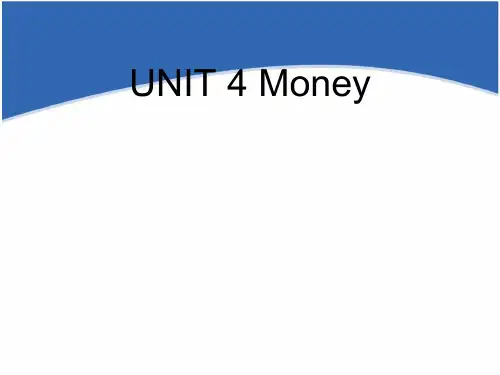
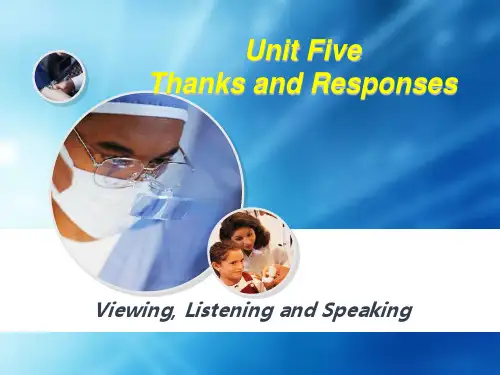
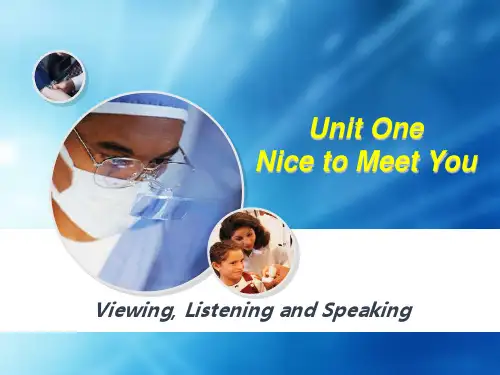
新标准大学英语视听说教程1课程设计一、教学目标本课程通过听、说、读的方式,主要让学生掌握以下技能:1.听力技能:能够听懂描述人物、地点、时间的日常对话;能够听懂简单的演讲和新闻报道。
2.口语技能:能够用简单的英语进行日常交际,并能表达个人观点。
3.阅读技能:能够阅读简单的英语文章,理解其主要意思和细节。
4.写作技能:能够写出简单的英语邮件和日常应用类文本。
二、教学内容1. Unit 1 My Family本单元的主要内容是介绍关于家庭和家庭成员的常用英语表达方式。
学生通过听、说、读的方式学习以下内容:•家庭成员的名称和关系;•描述家庭成员的外貌和个性特征;•谈论家庭成员的职业和兴趣爱好;•用英语介绍自己的家庭情况。
2. Unit 2 My School Life本单元的主要内容是介绍关于校园生活的常用英语表达方式。
学生通过听、说、读的方式学习以下内容:•谈论自己的学科课程和个人兴趣爱好;•描述校园环境和活动;•讨论教师和学生之间的关系;•用英语写邮件邀请同学参加活动。
3. Unit 3 My Hobbies本单元的主要内容是介绍关于个人爱好的常用英语表达方式。
学生通过听、说、读的方式学习以下内容:•谈论不同的爱好和运动;•描述自己的爱好和运动经历;•用英语讲述一次愉快的活动体验;•用英语写邮件邀请朋友一起进行活动。
三、教学方法1. 教师讲解法教师通过讲解和举例子的方式,帮助学生掌握英语语音、语法和常识。
2. 听力练习教师提供一些简单的日常对话和听力材料,让学生通过听力练习提升听力技能。
3. 口语练习教师以讨论或角色扮演的形式,让学生进行英语口语练习,增强沟通能力。
4. 阅读和写作练习教师提供一些简单的英语阅读材料和写作练习,让学生通过阅读和写作练习提升阅读和写作技能。
四、教学评估1.课堂测试对每个单元的教学内容进行测试,以检测学生的听力、口语、阅读和写作技能的掌握程度。
2.作业和小组讨论让学生在课后完成一些简单的阅读和写作作业,在下次课堂上进行小组讨论和分享,以提升学习效果。
新职业英语视听说教程(上册)教案Unit 1 OrganizationScriptU1-Listening 1 - Task 1Benjamin Good morning. I'm Benjamin Yang.Anna Good morning, Mr. Yang! I'm Anna Brooks. Can I help you?Benjamin Could you give me a brief introduction to your business?Anna Well, our company, Nova, is a leading producer and exporter of electronics andour products have a high reputation for quality and design in the internationalmarket.Benjamin Ms. Brooks, how long has your company been in this line of business?Anna For about 20 years since 1990.Benjamin Wow! How large is your company then?Anna Our company has more than 1,000 employees and our production and officespace covers 75,000 square meters.Benjamin That sounds great. Here is my résumé. I'd appreciate it if you could arrange me aninterview.Anna We'll read your résumé and call you later if you meet our requirements.Benjamin Thank you very much.Anna You are welcome.U1-Listening 1 - Task 2Good morning, everyone. Welcome to Nova. I'm Anna Brooks from the Human Resources Department. First, I'll give you a brief introduction to our company. Established in 1990, our company produces a variety of electronics, for both domestic and foreign markets. At present, we have an annual turnover of US$85 million. Next, I will say a few words about the organization of our company. As you can see from this chart, our company is headed by Mr. Jack Black and divided into six departments:R&D, Marketing, Sales, Production, Finance, and Human Resources. The biggest one is the Production with four sections: Purchasing, Quality Control, Maintenance and Transport. Any questions so far? U1-Watching 1 - Task 1Bob Alice, it's you! What a surprise meeting you here!Alice Hi, Bob. Haven't seen you for ages!Bob Yeah, we haven't seen each other since our graduation. How is everything?Alice I will start working for TAF from next month.Bob TAF? What do they do?Alice They're one of the leading manufacturers of skincare and hair care products,which are sold mainly in Southeast Asia and Africa.Bob When was the company set up?Alice In the early 1990's. It'll soon be celebrating its 20th anniversary.Bob How many employees are there in this company?Alice Over 6,000.Bob That is a big company! I'd like to wish you every success with your new job.Alice Thank you! How about you, Bob? Do you still work for Otis Elevator?Bob No, I've already left and started up my own business a year ago.Alice You're self-employed! That's marvelous! What line of business are you in?Bob I specialize in importing and exporting chemical products.Alice Fantastic! There might be chances for us to do business together.Bob Definitely. This is my business card. Let's keep in touch.Alice Sure.U1-Watching 1 - Task 2Alice May I come in?Bill Yes, come in, please.Alice Good morning, Sir. My name is Alice Zhao. I'm a newcomer to Sales &Marketing Department.Bill Good morning, Alice. Sit down, please. I'm Bill Smith, Manager of thisdepartment. Welcome to Sales & Marketing.Alice Thank you, Mr. Smith.Bill Just call me Bill. Have you reported to the Human Resources Department?Alice Yes, Sir.Bill Then, you've already got a brief introduction of our company?Alice Yes, Mr. Smith. But I am a bit confused about the organizational structure.Bill Well, it's not that complicated. Look at this organization chart.Bill The company is headed by the Board of Directors, which takes charge ofcompany strategies and general policies.Bill The Board usually appoints a CEO to take responsibilities for the company's dailyoperation.Alice Oh, I know Mr. Bruce Anderson is the CEO of our company. He was a businessprofessor at a famous college before he joined our company.Bill Yes. Our company is divided into five areas. They are: the R&D, the Sales &Marketing, the Production, the Finance, and the Human Resources.Bill The biggest one is the Production Department. It has four sections: Purchasing,Quality Control, Transport and After-sales.Alice What about our department then?Bill Since our markets are mainly in Southeast Asia and Africa, our department isaccordingly divided into two regional branches. Is that clear now?Alice Yes, very clear. Thank you.Unit 1 OrganizationScriptU1-Listening 2 - Task 1(Benjamin is chatting with another newcomer during the break.) Daphne We have the Board of Directors, the CEO, and the shareholders. What are thedifferences between them?Benjamin The shareholders own the company. They form the financial control system.Daphne What does the CEO do?Benjamin He is responsible for everything that happens in the company, acting as theofficial representative of the company. If there is only one person with absolutepower in a company, everyone knows the power will go to the CEO.Daphne Isn't that too dangerous?Benjamin You are right. That's the reason for having a Board of Directors. The Board ismade up of a group of independent and unbiased people, to whom the CEO isresponsible.Daphne What does the Board of Directors do?Benjamin They meet monthly, quarterly, or annually, providing long-term planning andvision, and acting as moral watchdogs to keep the company in line.U1-Listening 2 - Task 2Daphne Has the new project started?Benjamin Yes, all the departments involved are busy with it now.Daphne What departments are involved?Benjamin Three departments: R&D, Production and Quality Control.Daphne Teamwork again. How do they cooperate with each other?Benjamin First, the R&D designs new products. The keyword in this phase is innovation.Daphne Yes, that's why it takes a lot of effort, too.Benjamin Then the Production comes in. As soon as the design proves feasible, theProduction starts the assembly line and puts the design into real products.Daphne How does the Quality Control collaborate with the other two?Benjamin The QC takes random samples up to the lab for testing. Manufacturingproblems are reported to the Production and design problems go tothe R&D.Daphne I can see close cooperation among the three is the key to product quality.Benjamin You're right.U1-Watching 2 - Task 1Bill My name is Bill Smith. I'm the manager of Sales and Marketingat TAF. I'mresponsible for sales and promotion of the company's products. TodayI'mgoing to introduce to you my colleagues around the company. Here ismycolleague, Alice. Today is actually her second day in our companyand she'sgoing to help me with this video. Come on, Alice! Here is Victoria. Hi, Vicky!Victoria Hello, Bill.Bill Please Vicky... Could you just give your name, your job titleand a descriptionof what you do?Victoria Oh, is this for next week's trade fair?Bill Yes, we need to briefly introduce our company at the trade fair.Victoria OK. Is your camera ready? My name is Victoria Song. I'm an assistant managerfor international PR. I establish and maintain relationships withour overseaspartners.Bill Thanks, Vicky... This is Dave, Manager of the Production Department. Hi,Dave!Dave Hi, Bill. How's the preparation for the trade fair going?Bill Actually, I'm working on it right now! Could you give your name, your titleand a description of what you do?Dave Sure. Hello, I am Dave from the Production Department. We are responsiblefor developing and manufacturing products.Bill Thanks, Dave.U1-Watching 2 - Task 2Bill Hi, Alice, how is it going so far?Alice So far so good. Everything's interesting, except that the set-up here is still alittle confusing—who's where and what's what.Bill I see. Let me show you around and tell you how the company operates.Alice You are always so nice!Bill This way, please. Right there at the far end of the corridor on the right is theCEO's office. Have you met Mr. Bruce Anderson in person?Alice Not yet.Bill Next to the photocopy room is the Finance Department. If you have anyquestions concerning your payment, you can come here.Alice Payments for our products are handled here too, I guess.Bill Yes. They offer us statistics about our sales performance as well. Opposite theFinance Department is the R&D Department. Requests and complaints fromour clients shall be forwarded to them.Alice So, we'll cooperate a lot with the R&D.Bill Right. Another department we often work with is the Production Department,next to the R&D. Orders from our clients will go to them.Alice Are they responsible for dispatching and maintenance?Bill Yes. The Transport Section and the After-sales Section handle thoseresponsibilities.Alice Thank you very much, Bill.Bill By the way, if you have any trouble with your work, you can come to me. I'mthe first person you can turn to for help.Unit 1 OrganizationScriptU1-Supplementary Listening - Task 1A Where is H&M located?B It's located in Texas, USA.A How far is H&M from Scavo Town?B It's about 70 km south of Scavo.A What does the company produce?B It produces tires.A When was the company founded?B It was founded in 1983.A How many people work for H&M?B More than 2,000 people work for it.U1-Supplementary Listening - Task 2A My name is James Wilson, Business Manager of Sunshine Ltd. I've been withthe company for nearly 11 years. It's my pleasure to introduce our company toyou.B Thank you, Mr. Wilson. Would you please tell me where your company isbased?A It is based in Dongguan, Guangdong Province, fairly central to the Pearl RiverDelta and close to Guangzhou.B Oh, very good transport links. When was your company founded?A It was founded in 1983.B What does your company mainly produce?A Our main products are tires for cars and trucks, which are sold to countries andregions all over the world.B Your company is doing a great job in this field. Thank you for giving me such adetailed introduction.U1-Supplementary Listening - Task 3When you walk through the main gate, you will see a neat, 4-storeyed building about 50 meters away. That is our office building where all executive departments are located. To the left of the office building is a workshop with five floors. The assembly line is on the first two floors. There, our workers are busy producing quality tires around the clock. There are two warehouses at the back of the workshop. One is for raw materials, and the other is for finishedproducts. Beside the warehouses is a small building wheremaintenance staff work. They will be on the spot immediately if any machine breaks down. The yellow building on the right side of the office building is our canteen. It can cater for 2,000 people at the same time.U1-Supplementary Listening - Task 4Our company specializes in organizing cultural events and language courses. With 40employees, it is small in size, but quite complete in structure. The Managing Director is incharge of the whole organization including four departments: Science, English Language, Arts and Finance. The department managers report tothe Managing Director directly. The EnglishLanguage Department has two sections. One is the Cultural Section, dealing with variouscultural events related to English, and the other is the Examination Section, where language exams and courses are set up. The Arts Department also has two sections—the ExhibitionSection and the Library. The Finance Department is mainlyresponsible for managing company accounts and paying salaries. As our company is quite small, we don't have a team leader in each section but everyone works hard.U1-Supplementary Listening - Task 5A Good morning, Mr. Lee. I'm Helen Grey. I'd like to give you a general pictureof our company structure.B Thank you, Ms. Grey.A First, we have a Board of Directors. Philip Dickson is the Chairman, and AnneRoberts is the Managing Director, who reports directly to Mr. Dickson.B How many departments are there in the company?A Four in all: Production, Marketing, Finance and Personnel. David Peters is theProduction Manager, Fiona Harris is the Marketing Manager, and Mark Taylor,head of the Finance.B How about the Personnel Department?A Led by Nina Smith, the Department has two sections: Recruitment andTraining. Paul Rees is the Recruitment Manager and I am responsible fortraining.B Oh, I see. Thank you very much, Ms. Grey.A My pleasure. Hope you enjoy working here.Unit 2 OfficeScriptU2-Listening 1 - Task 1Jack Well, Mr. Anderson, I was wondering if I could come and meet you at 3 p.m.next Monday.Bruce Sorry, Mr. Black. I am afraid I have another appointment at that time.Jack Then how about next Tuesday?Bruce I am afraid I might be attending an opening ceremony in the morning andgoing to a conference in the afternoon.Jack Is Wednesday OK for you?Bruce I'll be leaving for Shanghai next Wednesday and probably won't be back untilFriday afternoon. Look, why don't I call you back and set the time later?Jack OK, let me tell you my telephone number.Bruce Oh, I have already got your number.Jack Good, when can I expect your call then?Bruce Maybe in a week or so.Jack I'll look forward to your call.U2-Listening 1 - Task 2Bill Alice, have you found the files I asked for? Mr. Anderson needs those filesbefore his meeting with Jack Black.Alice Sorry, Bill. I couldn't find any information on Jack Black. Maybe we don't havethe files in our department.Bill I am quite sure that the information was filed. Do you know we use thealphabetical filing system?Alice Yes. I have checked all the folders, but there is no file on Jack Black.Bill Have you tried Nova? Mr. Black is the CEO of that company. Sometimes, wefile documents by company names.Alice Oh, I didn't know that. Then I should look for the files under the heading "N".Bill That's right!Alice Oh, here they are! Are you looking for these?Bill Let me have a look. Yes, thanks, Alice!Alice You are welcome!U2-Watching 1 - Task 1Alice I need to fax this document to Nova. But I have never usedthis type of faxmachine before. Could you show me how to use it?Eric Of course. Where is the document?Alice Here it is. Two pages.Eric Alright. First, you turn the document face up; put it into the feeder here. Themachine will take the paper in automatically.Alice OK.Eric Then you dial the number of the receiver on the keypad. What's the number?Alice Oh, it's on this page, right here.Eric Good, you dial the number, and wait for the signals. When youhear the signals,press the "Send" button. It will automatically send the first page.Alice Do you mean the green button here? The "Start" button?Eric Yes, that's right. When the first page is finished, there's a "beep". You just needto feed in the second page.Alice Do I need to press the "Start" button again to send the second page?Eric Oh no, that's not necessary. When the last page is sent,there's another beep,and you'll see the display: FAX DONE. That's it.Alice I see. I think I can manage it now. Thanks a lot, Eric.Eric You are welcome.U2-Watching 1 - Task 2Alice Hi, Eric, we are running out of printer paper. Can we get some?Eric Sure. Wait a moment, please. I'll get you some.Alice Thanks. Oh, I think we also need some ballpoint pens.Eric No problem. This way, please!Eric We are planning to purchase some office supplies soon. Is there anything thatyour department wants to order?Alice Yes, we also need some small articles, such as pins, clips, staples, erasers andsticky notes.Eric Alice, would you please make a list of all the articles that your departmentneeds?Alice That's a good idea. I'll talk to Bill and other colleagues in my department andgive you the list tomorrow. Is that OK?Eric Sure! By the way, do you have any special requests?Alice Oh, yes! You've reminded me of something. I don't really like the pens we areusing now. They're poor in quality and don't write smoothly. Can we change toanother brand?Eric Of course. I'll try to find some good quality pens. Maybe we should go to someother suppliers. Don't worry!Alice That's great! I'll give you the list tomorrow.Unit 2 OfficeScriptU2-Listening 2 - Task 1Daphne This is Nova. Can I help you?Bill Hello, this is Bill Smith from TAF. Can I speak to Mr. Black?Daphne Oh, yes. Hold on, please!Bill Thanks!Daphne Mr. Black, there is a Bill Smith on the phone.Jack Put him through, please! Hello, Mr. Smith!Bill Hi, Mr. Black! I am calling to ask if you would like to see some samples of ourproducts before your meeting with Mr. Anderson.Jack Sure, of course. I'd be very glad to see the samples.Bill That's great! I am going to your city on a business trip tomorrow. Is it OK if Icome to your office and show you the samples during my visit?Jack Yes, of course. What about the day after tomorrow? Say 10o'clock in themorning?Bill Thanks. I look forward to seeing you then. Goodbye!Jack Goodbye, Mr. Smith.U2-Listening 2 - Task 2Eric Hi, Alice, are you going to work overtime again?Alice Yes, I need to prepare some documents for tomorrow's meeting.Eric You seem to be very busy these days. How many hours do you work each daynow?Alice 11 hours, 3 hours overtime each day. We are working on the Nova project, youknow... I believe things will be easier when it's done.Eric Goodness! That's pretty tough! Be careful that you don't make yourself ill!Alice Well, it's no problem for the moment. I am a newcomer, so this project is agood opportunity for me to get to know the company and our clients. What'smore, I can avoid traffic jams during the rush hours.Eric You are so optimistic! I am jealous of you—young, energetic, never becomingtired. How I miss my time of your age!Alice I am jealous of you too—experienced, wealthy, never becoming worried!Eric Ha-ha! The grass is always greener, so they say... Anyhow, take care! See youtomorrow.Alice See you. Have a good time!U2-Watching 2 - Task 1Bruce OK. Everybody is here. Let's start. Our focus today is theNova project. As youknow, the CEO of Nova, Mr. Black, will come to our company next week.Hopefully, we can sign a contract during his visit. So, all the paperwork mustbe done before he comes. Bill, how is your proposal going?Bill It's going quite well. I think I can finish it before this weekend.Bruce Good! We will discuss and finalize the proposal next Monday. How's yourmeeting with Mr. Black? Does he like our products?Bill Yes, he is quite satisfied with our products, but he doesn't really like thepacking.Dave Oh, yes. The packing is a problem. We are trying to improve it. The design isalready finished. I am sure the new packing will be ready before Mr. Black'svisit next week.Bruce Dave, please show me your design in my office after the meeting.Dave OK.Bruce Alice, have you sent the necessary documents to Nova?Alice Yes, Mr. Anderson. I have sent the materials about our company and ourproducts to Nova. I have received feedback from them too. Do you want totake a look?Bruce Sure, thanks! I'll keep these. Have you made photocopies?Alice Yes, I have.Bruce All right. It seems that everything is going well. Now, let's move on to the nextissue: our client strategy for Nova...U2-Watching 2 - Task 2Alice May I come in?Bruce Sure, come in. Hi, Alice, take a seat, please.Alice Thanks! Mr. Anderson, Bill said you wanted to talk to me?Bruce Yes, about your work. You've been doing quite an excellent job since you cameto our company last month.Alice Thanks! I think I still have a lot to learn.Bruce Well, that's true. We have noticed you are working very hard and learningpretty fast.Alice That's because I got a lot of help from Bill and other colleagues.Bruce Alice, you know Bill's assistant has left our company recently. So I am lookingfor someone to take her place. Are you interested in this position?Alice Really? I would be honored to take this position. I'll try my best to do my jobwell.Bruce Then, congratulations! You can start to work as his assistant tomorrow.Alice Thank you! Mr. Anderson.Eric Alice, you look so excited. Any good news?Alice Yes. Mr. Anderson wants me to be Bill's assistant.Eric Congratulations! Alice, I think we need to throw you a party to celebrate yourpromotion.Alice Thanks, Eric. You're always so kind!Unit 2 OfficeScriptU2-Supplementary Listening - Task 1A Should I rearrange these files in numerical order?B No, I prefer that they are arranged alphabetically.A Excuse me. I pressed the button, but nothing came out.B Let me have a look. Oh, the machine has run out of paper.A When are we seeing Mr. Brown this afternoon?B Don't you know? The meeting has been rescheduled to 4 o'clock tomorrowafternoon.A Have you finished your report, Linda?B If I were familiar with the new computer program, I would have finished it lastweek.A I'd like you to set up a staff meeting this Friday.B But we have already arranged a physical examination on that day.U2-Supplementary Listening - Task 2A Mike, is the overhead projector ready for the presentation?B Oh, sorry, I forgot to get it fixed.A But I told you to do it weeks ago!B I know. I am sorry. The meeting has just totally slipped my mind. I've been sobusy that I forgot to call the repairman.A I don't want to see this happen again.B Sorry, I don't know what to say. Let me see if I can borrow one.A Maybe you can go to the Administrative Department to see if we can use thesmall conference room on the 3rd floor. There are only six people attending themeeting.B OK, I'll go there right away. I promise this kind of mistake will never happenagain!A Well, I understand you are very busy these days. Take care.B Thank you.U2-Supplementary Listening - Task 3A Hello, can I speak to Mr. Brown?B Speaking!A Mr. Brown, this is Sara White. I am calling to tell you that I wouldn't be able tokeep my appointment with you tomorrow morning.A Due to unforeseeable circumstances, I have to leave for New York tomorrowmorning, and I'll be away for a week. I am sorry if I've caused you any trouble. B Never mind. It's understandable. Do you want to cancel the appointment? A No, I wonder if we can postpone it to next Thursday.B But I've got a very tight schedule next Thursday. How about next Friday? A Sorry, on Friday morning I have to give a presentation to the new employees. IsFriday afternoon good for you?B Friday afternoon is OK.A Then, let's make it Friday afternoon.U2-Supplementary Listening - Task 4A Jean, have you typed up the report?B Not yet, Mr. Black. I need to finish a few urgent letters first. Then I'll start onthe report.A Don't forget it. I need it for tomorrow afternoon's regional meeting.B I won't. I'll get it done today.A Then I guess you'll have to work overtime again.B Yes, I am planning to stay late and finish the report before 9o'clock.A I am sorry to keep you so late, Jean.B It's all right, Mr. Black. I'll leave the report on your desk so that you can see ittomorrow morning.A All right. Thanks, Jean.U2-Supplementary Listening - Task 5A Miss Li, have you made the necessary arrangements for the meeting?B Yes, Sir. The handouts as well as the conference room are ready. And all theequipment is in working order.A That's good. This meeting is very important. Where will the guests be receivedbefore the meeting begins?B In the VIP lounge. It's spacious there.A Good. How can we communicate with the foreign guests?B I've arranged for an interpreter to be present. But I've heardthat the foreignguests can speak Chinese.A Oh, that's good. Then how do you plan to seat our guests?B We've prepared name cards on the conference table.A How about the microphones and speakers?B I have got them ready too.A Good! Who is going to take the minutes?B I'm going to take the minutes.Unit 3 Business MealsScriptU3-Listening 1 - Task 1Bill Hello! Is that Ms. Susan Jones?Susan Yes, speaking.Bill Ms. Jones, this is Bill Smith from TAF. I heard that you are in China for aneconomic forum.Susan Yes, Bill! I arrived yesterday. I was just about to call you and ask if I couldvisit your company while I'm here.Bill It would be an honor to have you visit us! Are you free on Friday? I would liketo invite you to a dinner party that evening.Susan Thank you so much! What's this party for?Bill It's just an informal party, our annual get-together for all our branch officedirectors.Susan Oh, that would be great! I can finally get to see my Chinese partners.Bill Excellent. Would Friday 6:00 p.m. be OK with you?Susan Yes, it's fine.Bill Alright. I will come to pick you up at your hotel at 5:30. See you then.Susan Thank you and see you Friday.U3-Listening 1 - Task 2Alice Good morning, Mr. Collins!Collins Good morning, Alice. Haven't seen you for ages! How are you doing?Alice Fine, thank you. Mr. Collins, we are inviting all our branch office directors fordinner on Friday evening. Do you think you can host a party of about 20people?Collins We can host a party for an army!Alice I'm glad to hear that. But there is something I need to tell you. One of thedirectors is Muslim. He has strict food taboos on pork.Collins No problem. I will prepare some dishes absolutely pork free.Alice One of them is vegetarian and another director has high blood pressure. It issuch a headache to cater for them all at once.Collins In that case, I suggest you set up a buffet together with some finger food. Theguests can choose whatever they like.Alice Yes, you're right. What beverages should I serve?Collins Beer would be a good choice. For non-drinkers, they can have mineral water,with a variety of juices and soft drinks.Alice That's a neat idea. You have just solved all my problems.U3-Watching 1 - Task 1Receptionist Four Seasons. May I help you?Alice I'd like to book a table for two.Receptionist For what time, please?Alice For 12:15 Thursday afternoon.Receptionist I am sorry. There isn't a table available until 12:30.Alice 12:30 will be alright.Receptionist Is it in your name?Alice No, under the name of Mr. Bill Smith, please.Receptionist Ah, Mr. Smith is our VIP guest. It'll be our pleasure to have him with ustomorrow. What kind of table would you like to have?Alice A table in the non-smoking area. Smoke really bothers Mr. Smith.Receptionist Don't worry. Smoking is prohibited in our restaurant.Alice Would you please make sure the table is far away from the piano? Mr. Smithprefers a quiet atmosphere.Receptionist I see. Let me confirm your reservation. A quiet table for two at 12:30 onThursday.Alice That's right. Thank you!。